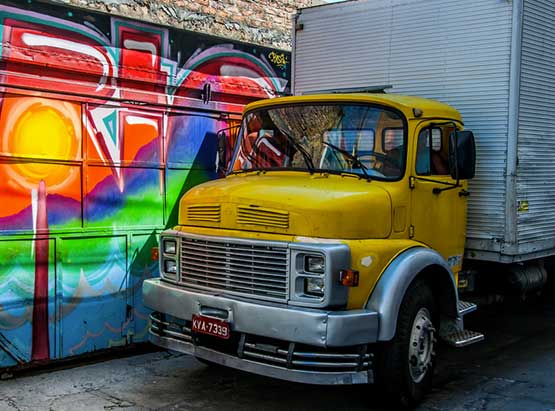Standard type
Fuel-economy standard
Regulating Body
The Ministry of Energy of Chile
Applicability
Light-duty vehicles (gross weight < 2700 kg)
History
In February 2022, Chile’s Ministry of Transportation and Telecommunications published Energy Efficiency Law 21305. Among other things, the law sets the nation’s first fuel economy standards for light-duty internal combustion engine (ICE) vehicles to reduce greenhouse gas emissions from its transportation sector.
Technical Standards
Under the Energy Efficiency Law, Chile is required to meet new fuel economy standards for light-duty vehicles starting in 2024. Vehicle manufacturers are responsible for meeting regulatory compliance. Fuel economy is calculated on a fleet-wide basis, consisting of the average performance of individual vehicle testing certificates for each manufacturer. The following equation can be used to represent the variable energy efficiency standard that must be met by each manufacturer:
Standardi_j = Standardref_j + a * (Mi_j – M0)
Where:
- Standardi_j: The fuel economy standard in kilometers per liter of gasoline-equivalent (km/lge) to be met by manufacturer “i” in year “j.”
- Standardref_j: The fuel economy reference standard, before vehicle weight is considered, established in year “j.” The reference standard increases in stringency over the course of the regulatory period.
- a: A constant value equal to -0.0043 km/lge
- Mi_j: The fleet-wide average weight (kg) for manufacturer “i” in year “j.” The weight used here is a reference weight that considers the weight in running order plus an additional 100 kg to account for the driver, fuel, and other small items the driver may be carrying.
- M0: Corresponds to a value equal to 1,375 kg.
Chile does not explicitly set separate light-duty vehicle standards for passenger vehicles (PV) and light-commercial vehicles (LCV). The reference standard (Standardref_j) in each regulatory period applies to both vehicle categories, but since reference standards are adjusted based on the manufacturer’s fleet-wide average weight of each vehicle type, LCV fleets will have a lower level of compliance due to their heavier weight. The opposite is true for passenger vehicles, which must comply with slightly higher standards due to their reduced weight. For all light-duty vehicles, there will be a progression of target values as seen in Table 1. These will continue to increase until 2030.
| Year | Value (km/ lge) |
|---|---|
| 2020 (Baseline) | 14.9 (PV), 13.5 (LCV) |
| 2024-2026 | 18.8 (PV), 18.3 (LCV) |
| 2027-2029 | 22.8 (PV), 22.3 (LCV) |
| 2030-future | 28.9 (PV), 28.4 (LCV) |
For the regulatory period occurring after 2030, the Chilean government has announced that it will continue to work with the auto industry to (1) double the efficiency of all new light-duty vehicles entering the country by 2035 and (2) quadruple their efficiency by 2050 with the year 2019 as a baseline. Post-2030 targets are yet to be decided as of 2022.
Test Cycle
Chile uses the European Union’s New European Driving Cycle (NEDC) to determine the fuel economy of each vehicle as outlined in Supreme Decree No. 211 (1991) of the Ministry of Transport and Telecommunications. Expressions for calculating fuel economy for individual traditional and electric vehicles in km/lge can be found in Article 1 of the Energy Efficiency Law 21305, sections 4a and 4b, respectively.
Compliance
Chile’s Ministry of Transportation and Telecommunications supervises compliance for all individual vehicle testing certificates submitted during the year. Vehicle manufacturers are subject to fines imposed by the Superintendence of Electricity and Fuels for non-compliance. Fines of up to 0.2 Unidades de Fomento (a non-circulating unit of account continually adjusted for inflation) for each tenth of a kilometer per liter of gasoline-equivalent below the standard defined for a given year, multiplied by the total number of individual vehicle testing certificates granted to the manufacturer. The expression for calculating fines associated with non-compliance is as follows:
Finei_j [UF] = Factor ∗ 10 ∗ (Standardi_j – Performancei_j) ∗ Ni_j
Where:
- Finei_j: The annual sanction imposed by the Superintendence of Electricity and Fuels, to be paid by the manufacturer “i” for non-compliance with the fuel economy standard in the year “j” in Unidades de Fomento.
- Factor: A value of up to 0.2 km/ lge, determined by the sanctioning process of the Superintendence of Electricity and Fuels
- Standardi_j: The fuel economy standard to be met by manufacturer “i” in year “j.”
- Performancei_j: The fleet-wide average fuel economy in km/lge for the total number of vehicles for which individual vehicle testing certificates were issued to the manufacturer “i” in year “j.”
- Ni_j: Total number of vehicle testing certificates granted to manufacturer “i” in year “j.”
Manufacturers subject to fines for non-compliance are permitted to “over comply” with the established standard in the following year. In this case, the amount resulting from multiplying each tenth of a kilometer per liter of gasoline equivalent over the required amount may be deducted from the previous year’s fine.
Manufacturers that produce electric or plug-in hybrid vehicles can designate multipliers of three for such zero-emission vehicles (ZEVs), which means they may count a ZEV’s individual energy efficiency up to three times when calculating the average fuel economy of their overall fleet. This option encourages ZEV uptake and helps to improve the manufacturer’s corporate average fuel economy in the short term. The exact expression for calculating ZEV energy efficiency can be found in Article 2, section 11 of the current standard. Additionally, zero-emission vehicles and plug-in hybrids owned by companies have an accelerated depreciation tax benefit, translating to lower taxes for a period of ten years after the law goes into effect (2024).

